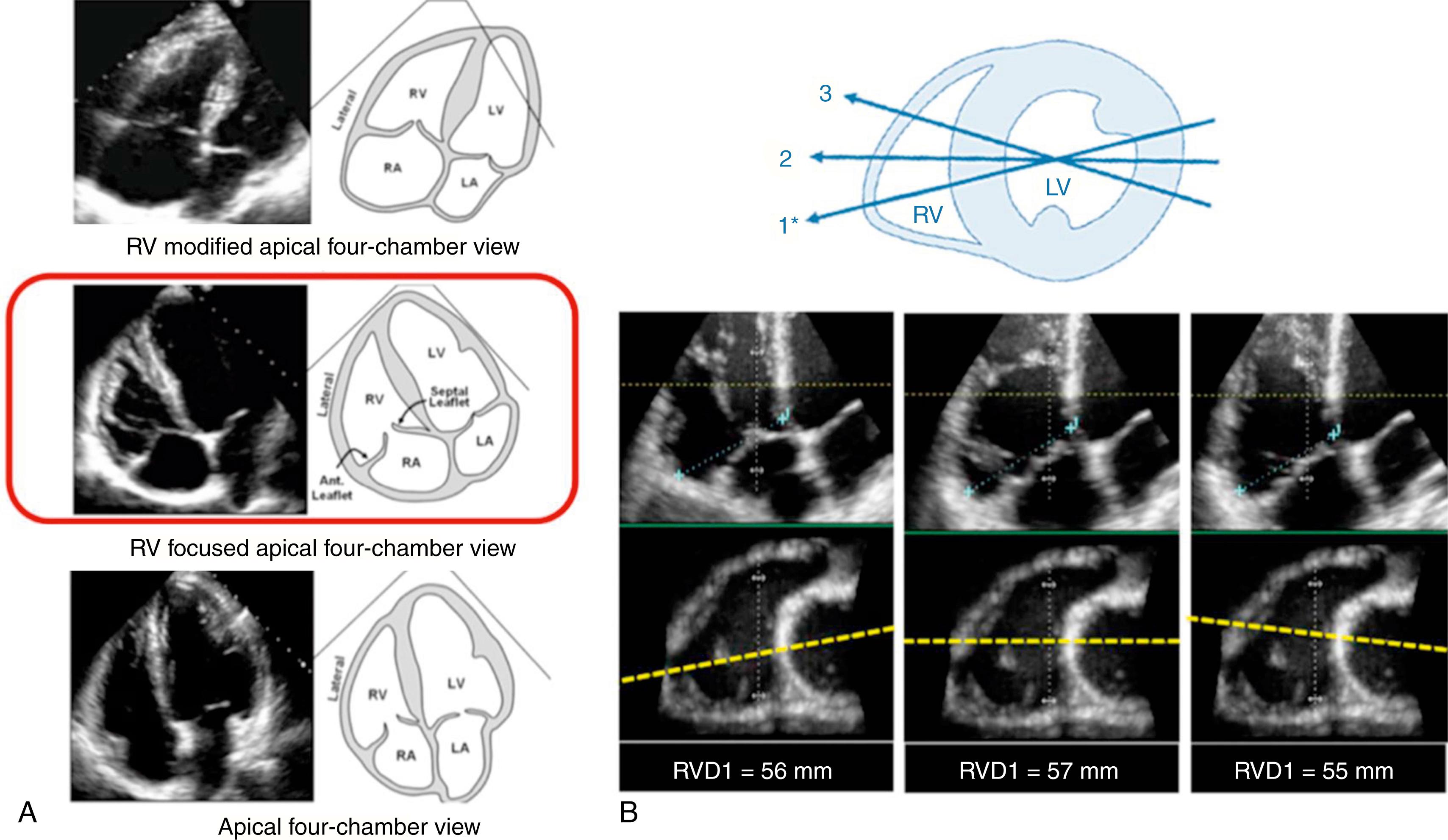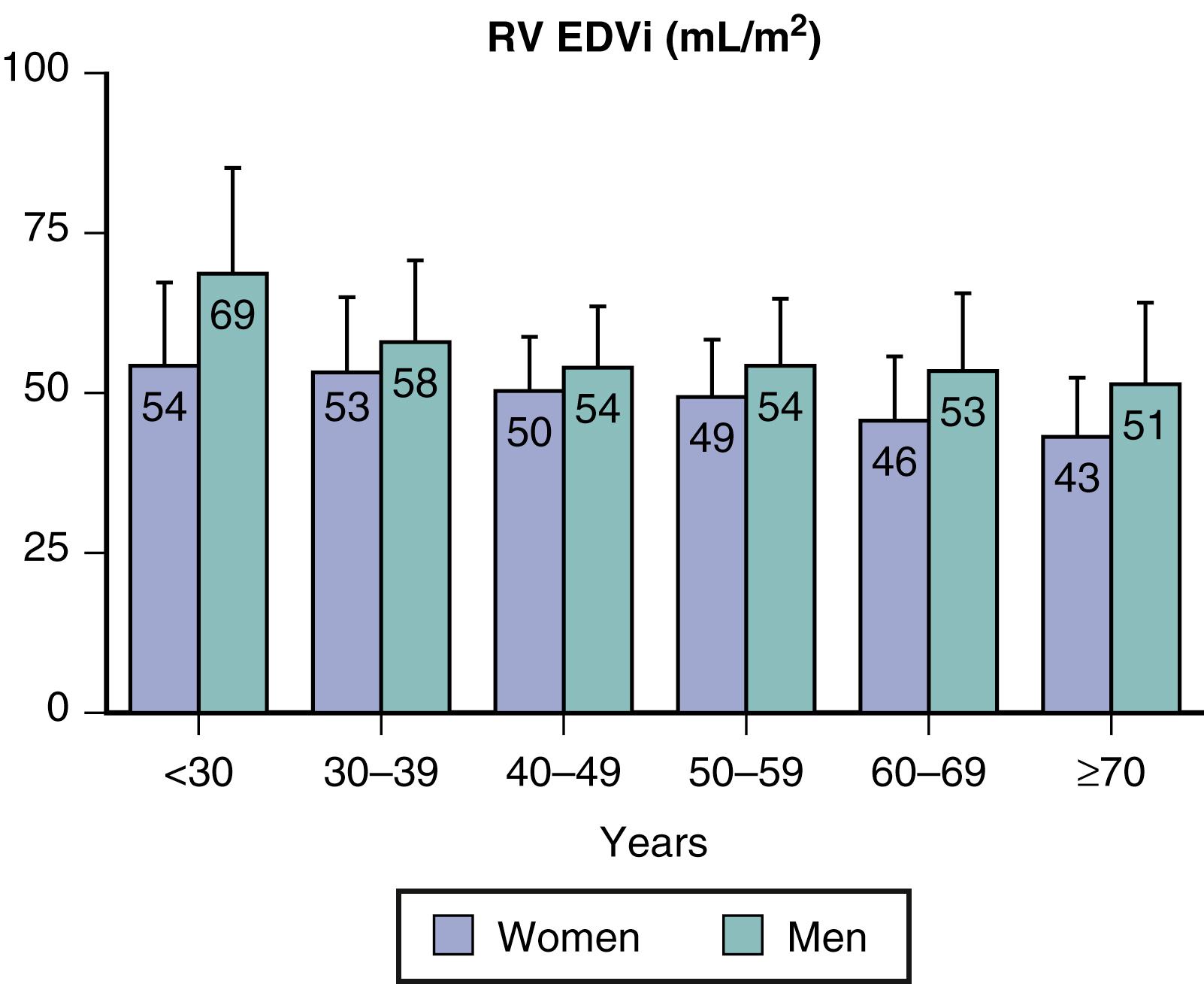Physical Address
304 North Cardinal St.
Dorchester Center, MA 02124
The right ventricle (RV) plays a key role in the outcome of many disease states. RV dysfunction is associated with excess morbidity and mortality in patients with chronic left-sided heart failure (HF), acute myocardial infarction (MI), pulmonary embolism (PE), pulmonary arterial hypertension (PAH), and congenital heart disease. Despite this knowledge, a standardized approach toward the echocardiographic assessment of the RV was only developed and applied a decade ago, with revised recommendations in 2015. , This chapter focuses on how to assess RV function, with an emphasis on newer techniques.
The right side of the heart receives the systemic venous return from the superior and inferior venae cavae. The right atrium serves as a conduit and a pump, filling the right ventricle via the tricuspid valve. The right ventricle then ejects its stroke volume (SV) through the pulmonary veins (PVs) and into the pulmonary artery (PA). In the absence of a shunt, right-sided SV should be equal to that of the left side. The right side of the heart differs from the left in terms of anatomy and physiology in several important ways. Although the left ventricle (LV) can be modeled as a prolate ellipse, the RV loosely resembles a pyramid that wraps around the LV and is composed of three portions: the inlet, the body, and the outflow tract. Contraction is generated by a deep subendocardial layer of longitudinal fibers that cause a base-to-apex motion and a superficial layer of circumferential fibers that cause inward contraction. Recent data from three-dimensional (3D) imaging suggest that this inward motion is more important than previously thought. The RV lacks the third layer of spiral fibers that are present in the LV. The RV end-diastolic volume (EDV) is slightly greater than that of the LV, and as a result, the RV has a slightly lower ejection fraction (EF). This is accomplished with a mass that is approximately one-fifth that of the LV. Accordingly, the RV is well suited as a volume pump, but is prone to failure when faced with an acute pressure challenge. , In chronic volume overload states, such as in the setting of severe tricuspid regurgitation (TR) or pulmonic regurgitation (PR), or in the presence of a shunt, the RV responds by enlarging in an attempt to restore forward SV. With chronic pressure overload, such as with pulmonary hypertension (PH) or pulmonic stenosis, the RV initially responds with hypertrophy of the wall in an attempt to normalize wall tension. Eventually, when compensatory mechanisms fail in the setting of severe PH and increased transmural pressure, myocardial blood flow decreases because of the loss of coronary flow during systole.
The complex anatomic and physiologic differences just described present many challenges in the noninvasive echocardiographic evaluation of the dimensions and function of the right side of the heart. A wide variety of methods to describe RV size and function have been developed, none of which provide a complete picture, but recent advances in 3D echocardiography (3DE) and new understanding of the assessment of myocardial contractility have yielded new insights and methods of standardization.
Quantitation of RV dimensions is critical and improves interrater variability when compared with visual assessment alone. Measurements by two-dimensional echocardiography (2DE) are challenging because the geometry of the RV is complex and it lacks specific right-sided anatomic landmarks to be used as reference points. The conventional apical four-chamber (A4C) view (i.e., focused on the left ventricle) results in too much variability on how the right side of the heart is projected, and consequently, RV linear dimensions and areas may vary widely in the same patient with relatively minor rotations in transducer position ( Fig. 30.1 ). RV dimensions are best estimated from a RV-focused A4C view with an upper reference limit of 42 mm ( Fig 30.2 ). The RV-focused view consistently results in larger values than the traditional A4Cview and has less inter- and intraobserver variability and reduced test–retest variability. Care should be taken to obtain the image with the LV apex at the center of the scanning sector while simultaneously displaying the largest basal RV diameter that prevents foreshortening. Other dimensions that can be measured are the midchamber (35-mm limit), longitudinal diameter (83 mm but of little clinical utility), and RV outflow tract (RVOT). The proximal RVOT diameter is used to diagnose arrhythmogenic right ventricular cardiomyopathy (ARVC), whereas the distal RVOT diameter can be used to help calculate the ratio of pulmonic to systemic flow (Qp:Qs) in the presence of a shunt.


Recent data have suggested that indexing RV size to body surface area (BSA) may be relevant in some circumstances; however, the measurements used in these studies lacked the reference points of the RV-focused view and frequently use RV areas rather than linear dimensions. , As such, indexing should be considered only at the extremes of BSA but may be used in assessing RV volumes (see later).
Because of the complex asymmetric shape of the RV, only a volumetric method such as 3DE can provide a truly reliable measure of its size. Unlike 2DE, accuracy of 3DE does not depend on the imaging view or unverified geometric assumptions regarding RV shape. If image quality is accurate and heart rhythm is fairly regular, RV volumes measured by 3DE have excellent reproducibility and are in close agreement with those obtained using cardiac magnetic resonance (CMR). , Measurement of RV volumes is recommended for the clinical evaluation of RV size in laboratories with experience in 3DE. Age, gender, and body size are important determinants of RV volumes measured either by 3DE or by CMR ( Fig. 30.3 ). Preliminary results from the World Alliance Societies of Echocardiography (WASE) study suggest that RV volumes also depend on ethnicity. An RV EDV of 87 mL/m 2 in men and 74 mL/m 2 for women and an RV ESV of 44 mL/m 2 for men and 36 mL/m 2 for women have been recommended by American Society of Echocardiography (ASE)/European Association of Cardiovascular Imaging (EACVI) guidelines as the upper limits of the corresponding normal ranges. Patient-specific normative ranges from allometric equations may be applied when confirming RV enlargement using 3DE.

Become a Clinical Tree membership for Full access and enjoy Unlimited articles
If you are a member. Log in here